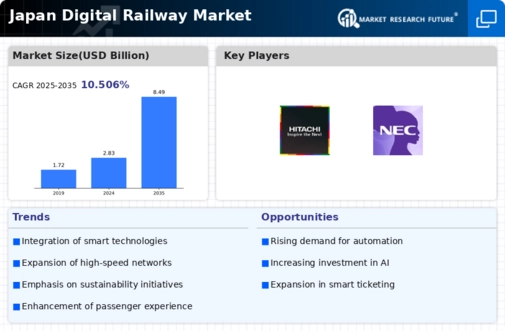The Japan Digital Railway Market has experienced significant developments over the years, driven by advancements in technology, changing consumer preferences, and a growing emphasis on sustainability. The competitive landscape is characterized by both established players and new entrants who are leveraging innovative technologies to enhance operational efficiency and improve passenger experience. Digitalization in the railway sector encompasses various aspects, including real-time data analytics, automated ticketing systems, and intelligent train management solutions.
As Japan strives to maintain its reputation for high efficiency and reliability in public transportation, companies within this market are focusing on building robust competitive advantages through cutting-edge technologies and strategic partnerships.Hitachi Rail is the undisputed market leader in Japan's digital railway sector, providing full rail solutions that include signalling, train control, automation, and predictive maintenance. The business created and operates ATOS (Autonomous Decentralized Transport Operation Control System), which is widely utilized on JR East commuter lines, as well as MARS, the JR Group's backbone reservation system.
Hitachi leverages its Lumada IoT and AI platform to allow real-time diagnostics, energy efficiency, and automated traffic control. It is actively involved in updating Shinkansen operations, hence improving safety and punctuality.
With end-to-end integration of rolling stock, control systems, and data analytics, Hitachi Rail is at the heart of Japan's railway digital revolution and continues to export its breakthroughs to worldwide markets, maintaining its leading position. Nippon Signal Co., Ltd. is a leading manufacturer of signalling systems in Japan, specializing in modern safety-critical rail infrastructure. The company supplies electronic interlocking systems, automatic train stop (ATS) devices, train detection sensors, and digital route control systems to JR Group companies, private rail operators, and metros around the country.
It was instrumental in the deployment of ATACS (Advanced Train Administration and Communications System), Japan's counterpart to CBTC, which is already operational on a few lines.
Nippon Signal is also an active participant in train approach warning systems, platform screen doors, and integrated traffic control centers. Its excellent R&D expertise and emphasis on domestic deployment provide highly customized, dependable signalling systems, cementing its position as a key component of Japan's digital railway transformation.












